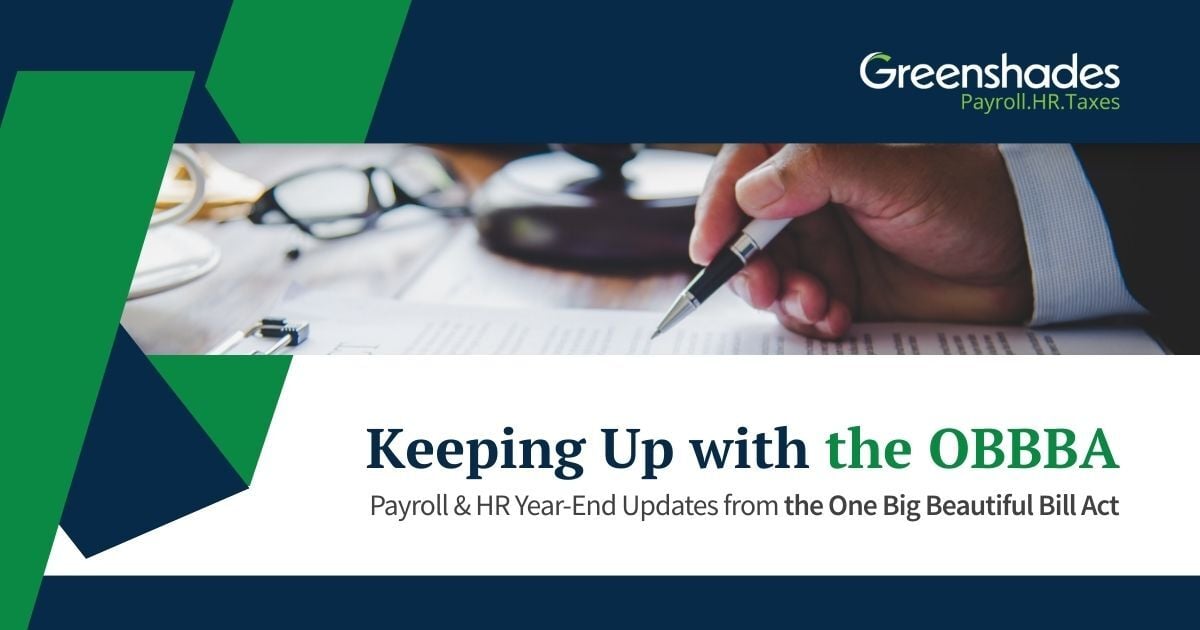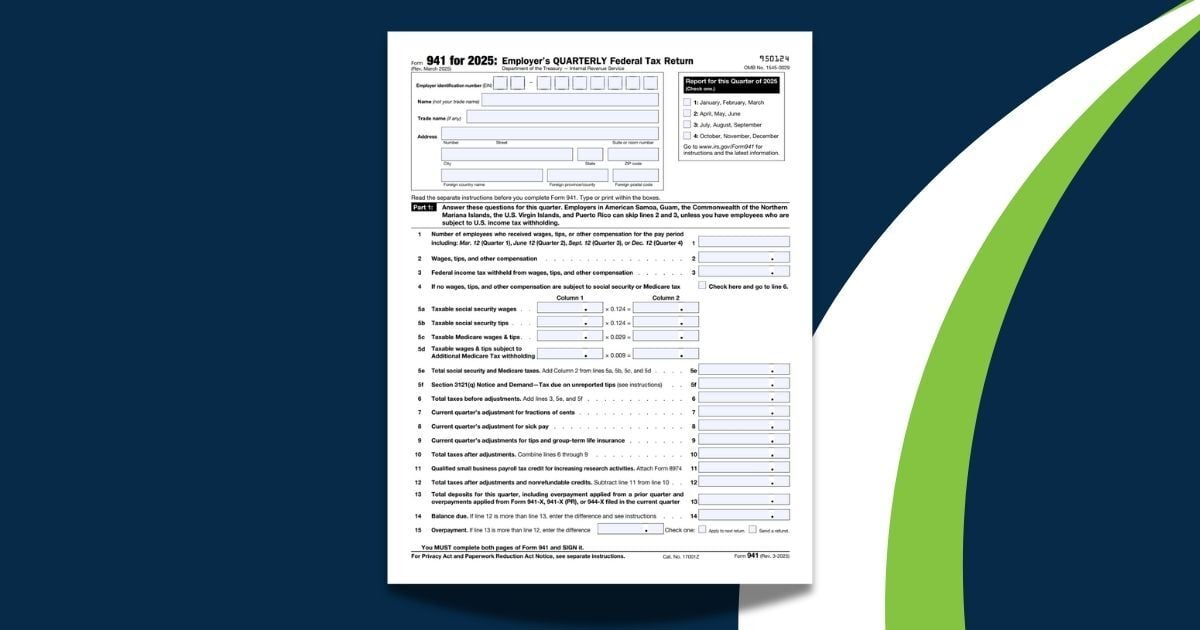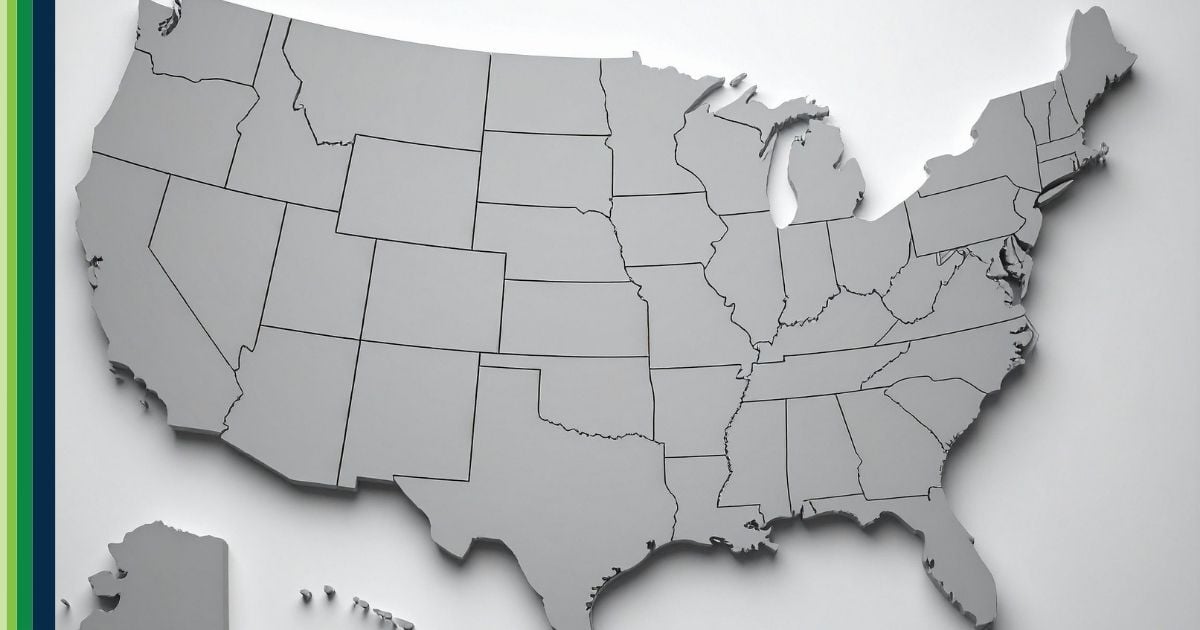In each issue of Compliance Corner, we discuss topics that the Greenshades Compliance team tracks and maintains. Here are several more that you may not be aware that Greenshades supports.
Note: The information provided is current as of September 30, 2025. Everything provided is for informational purposes only and does not constitute formal tax, legal, or compliance advice. Always consult with qualified tax advisors, legal counsel, and your organization’s internal teams for guidance specific to your situation. Additional regulations may apply. For the most accurate and up-to-date information, refer to official government resources and regulatory agencies.
In This Issue:
- All about Greenshades Compliance
- Noted Compliance Changes
- Child Support
- Changes to Annual Returns for TY2025
- One Big Beautiful Bill Act: What we know so far
Compliance is not just assigned to one department. We are here for all of the departments that offer products to our many and varied clients.
Compliance Areas of Focus
EEO-1, Component 1
Private sector employers with over one hundred employees are required to file an annual EEO-1 Component 1 to the U.S. Equal Employment Opportunity Commission (EEOC). Some federal contractors with fifty or more employees must also submit workforce demographic data, in addition to private sector employers.
This report takes a snapshot of your employees within the specified period determined by the EEOC. The report groups data together by type of positions held; Male or Female; and Hispanic or Latino, White, Black/African American, Asian, Native Hawaiian/Other Pacific Islander, American Indian, or mixed race. The reporting window for Tax Year 2024 was open from May 20th to June 24th of 2025.
Local Income Taxes
Did you know that there are over 9,000 variations of local taxes? Pennsylvania alone has over 2,600 (Earned Income, both resident and non-resident rates, and Local Service Tax); Ohio has municipal and JEDX taxes, plus School Districts; Kentucky, Maryland, Michigan, Colorado, Alabama, Oregon, West Virginia, Delaware, Missouri, and New York.
We track the changes to the rates, add in new local tax jurisdictions, and monitor and update who are the assigned tax collectors. We review this information quarterly to identify changes and then provide a list of the jurisdictions with changes via email.
Noted Changes
When changes occur, compliance provides information on the how and when they will affect the processes in place and the information detailing the changes in portals, specifications, security (MFA and captchas) must be researched and provided to implement on time and correctly.
- Michigan is moving to a new unemployment (MiUI) portal in December 2025. The first quarterly wage report will be due in January 2026. In December, employers will receive an 8-digit code in their MiWAM account that will be used to activate their MiUI accounts. In contrast, the setup of TPA accounts will take place within MiUI.
- Texas is moving to a new unemployment website (TxUS). It is designed to consolidate and streamline unemployment tax related processes, integrating the functionalities of Unemployment Tax Registration (UTR), Unemployment Tax Services (UTS), QuickFile, the GoAnywhere portal, and Magnetic Media into a single, user-friendly platform.
- Retro-active to May 27, 2025, the hourly rate of Philadelphia’s paid sick leave for tipped employees is higher of the normal rate or the minimum wage rate of the average of the minimum wage rate for bartenders, waitstaff and dining room attendants. POWER Act
- Tennessee garnishments – employers must determine, within 2 business days, whether they possess or control the money of the employee and, if so, place a hold on the available funds. Then the employer must mail, first class mail, a copy of the notice to the employee. SB 765
- Minnesota wage garnishments, all but child support, now have tiered Section 571.922
- Nebraska’s sick time law has been revised to employers with 11 to 19 employees (not zero to 19) and 20 and over employee tiers. LB 415
- Missouri Paid Sick Leave, is repealed effective Aug 28, 2025. HB 567
- Maine Paid Leave, effective 9/24/2025, LD 55, modifies the law to allow employees to continue accruing, up to 40 hours, even if they carried forward unused leave.
- Maine Paid Family Medical Leave, effective 1/1/2026, employers will be required to withhold and remit employee contributions for PFML. HB163
- Virginia has passed a law (VA Code 40.1-29.2(A)) that outlines a specific formula for overtime earned by non-exempt salaried employees.
- Vermont, VT Saves, effective July 1, 2025, employers with 25 or more employers, a state-mandated retirement savings program for employees. Program automatically enrolls new hires in a ROTH IRA that the employee contributes 5% of their pay; unless the employee opts out of the program.
- ACA affordability percentage for 2026 is 9.96%
- The Social Security taxable wage base for 2026 is $183,600.
- Effective 1/1/2026, New Mexico’s quarterly withholding returns will be due on the 25th day of the month following the end of the quarter.
- Effective September 30, 2025 all federal payments currently issued by paper check must be made electronically pursuant to Executive Order 17247, Modernizing Payments To and From America’s Bank Account.
- The 2025 Form 940 and 2026 Form 941 are being updated to include what type of Aggregate Return Filer you are if applicable.
- You can now access your transcripts from your IRS.gov/BusinessAccount. More information can be found at https://www.irs.gov/businesses/get-a-business-tax-transcript
Child Support
The Office of Child Support Services (OCSS) announced several upcoming software changes and their release dates [OCSS, Release 25-02, April 2025]. The one of most interest to employers is an enhancement to the Debt Inquiry and Employer Reporting Portal applications,
which will speed up lump-sum reporting. The release date is set for July 2025.
Enhancements to applications
Both applications will be enhanced to allow states to directly respond to employers’ reported lump-sum matches on the Debt Inquiry application. Enhancements to the Debt Inquiry application will enable states to inform employers whether to release or withhold a lump-sum payment. If withholding is required, the state will provide the arrearage amount, the percentage to withhold from the lump-sum payment, along with additional comments or instructions. Further enhancements will allow employers to view the state responses and acknowledge the lump-sum match.
E-NMSM
The electronic National Medical Support Notice (e-NMSN) is an efficient and cost-effective way for child support agencies to exchange NMSNs with employer partners (employers, third-party providers, plan administrators, and unions).
Federal Government
- The IRS has published the draft of the federal W-4 for 2026. It incorporates the handling of the exempt tip and overtime income.
- Line 3 can be used to capture the increase of the Child Tax Credit ($2,000 to $2,200)
- Line 4b (see page 5 for the deductions worksheet) to capture these credits:
- Line 1a Tip Income
- Line 1b Overtime compensation
- Line 3 Senior $6,000 credit
- The IRS updated Form 656-B, Offer in Compromise Booklet, which contains the forms need to submit an offer to resolve tax debt with the IRS.
- Lists of states/cities/counties that have Disaster relief can be found on an IRS Tax-Relief-In-Disaster-Situations.
- IMAGE is a Mutual Agreement between Government and Employers that provides employers with solutions to hiring process challenges through outreach and education with the goal of fostering workforce integrity and compliance with the law.
- Student Loans. The Education Department can instruct employers to withhold up to 15% of an employee’s disposable pay to collect defaulted student loan debt. No more that the lesser of 15% of the disposable pay or the excess of the employee’s disposable earnings over 30 times the federal minimum wage may be garnished unless the employee consents to a higher amount.
- There is a new procedure to request an extension of time to furnish recipient copies of form W-2. You must complete Form 15397, Application for Extension of Time to Furnish Recipient Statements, to request an extension of time for copies 2, B, and C to employees.
- The US Department of Labor is returning the PAID program (Payroll Audit Independent Determination). It will now include potential violations from the Family Medical Leave Act (FMLA). This program allows employers to correct mistakes and ensure that the employee receives the correct back pay without the employer having to face a court case or pay penalties. More information can be found
The IRS has a webpage to assist in claiming these credits during the 2025 calendar year.
E-Verify
The Department of Homeland Security was sending case alerts to notify E-Verify employers when they have revoked an employee’s Employment Authorization Document (EAD). Now employers need to monitor the Status Change Report to follow-up on EADs that may have been revoked.
Employers must reverify the employee’s I-9 using Supplemental B based upon the case listed on the Status Change Report. Additional information can be found here.
It is recommended that you monitor Temporary Protected Status (TPS) designations, as many are being terminated that are identified to specific countries. You can monitor this information here. Those with expiring or terminated TPS must be reverified.
Effective January 1, 2026, Arkansas will start to require E-Verify for all new hires.
Currently, the following states require E-Verify:
For all employers: Alabama (April 2012), Arizona (January 2008), Mississippi (July 2011), Montana (July 2025), and South Carolina (April 2012)
For private employers: Georgia (July 2013 – 11+ employees)
For public employers: Colorado (2006), Idaho (2009), Indiana (2011), Michigan (2012), Oklahoma (2007), Virginia (2011), and West Virginia (2024).
Hybrid Version:
Florida (July 2023 – Private employers with 25+ employees and all public employers), Louisiana (January 2012 – Private employers contracting with a LA Public entity for physical services), Minnesota (2011 – state contracts), Missouri (2009 – public employers and state contracts), North Carolina (July 2013 – all public employers and Private employers with 25+ employees), Pennsylvania (Contractors 2020), Tennessee (January 2023 – all public employers and Private employers with 35+ employees, Texas (2015 – State agencies and higher education), and Utah (July 2010 – all public employers and Private employers with 15+ employees).
One Big Beautiful Bill Act: What we know so far
- Tips up to $25,000 are exempt from federal income tax. The amount will start to phase out as income reaches $150k for a single filer and $300k for joint filers.
- Overtime (premium only) is exempt from federal income tax $12,500 for a single filer and $25,000 for MFJ. The amount will start to phase out as income reaches $150k for a single filer and $300k for joint filers.
- Overtime must be FLSA-qualified: The deductible amount is limited to the overtime premium that employers are required to pay under the federal Fair Labor Standards Act (FLSA). This means it applies to hours worked beyond 40 in a workweek, not additional overtime mandated by state law or a collective bargaining agreement.
- Temporary exemption of up to $6,000 for individuals 65 and over and $12,000 for joint filers if both qualify. The amount will start to phase out as the adjusted gross income reaches $75k for single filers and $300k for joint filers.
- Standard deductions have increased by approximately $750 per taxpayer (except for HOH $1,125)
- The IRS is not updating the tax tables or forms for 2025.
- The IRS will provide transition relief for taxpayers to claim exemptions for 2025.
- 2026 W-2 is available in draft form
- Box 14 will now contain:
- 14a Other (for everything we used to
post here before) - 14b Treasury tipped occupation code
- Box 14b. Employers use this box to report the Treasury Occupation Code for your tipped occupation. Use this code in reporting the deduction for qualified tips on Sch. 1-A (Form 1040).
- And they have added 3 new W-2 Box 12 codes:
- TA—Employer contributions to your Trump account.
- TP—Total amount of qualified tips.
- Use this amount in determining the deduction for qualified tips on Sch. 1-A (Form 1040).
- TT—Total amount of qualified overtime compensation. Use this amount in determining the deduction for qualified overtime compensation on Sch. 1-A (Form 1040).
- 2026 W-4 available in draft form
- Line 3 can be used to capture the additional Child Tax Credit (increased to $2,200). The refundable portion remains at $1,400.
- Line 4b can be used to capture the:
- OT exclusion
- TIP income exclusion
- $6,000 65 and over tax credit
Note: If employees want to capture the savings during the current tax year, they will need to update their W-4, lines 3 and 4b. Go to this site for additional assistance.
The Treasury Department has provided the list of the qualifying tipped positions. These codes will be entered in box 14b on the 2026 W-2.
Definition of Qualified Tips
In order to claim the deduction, a worker must both be in an occupation on the list and receive qualified tips. IRS Newswire Issue #IR-2025-92 The proposed regulations provide a definition of qualified and not qualified tips which includes the following factors:
- Qualified tips must be paid in cash or an equivalent medium, such as check, credit card, debit card, gift card, tangible or intangible tokens that are readily exchangeable for a fixed amount in cash, or another form of electronic settlement or mobile payment application (excluding most digital assets) denominated in cash.
- Qualified tips must be received from customers or, in the case of an employee, through a mandatory or voluntary tip-sharing arrangement, such as a tip pool.
- Qualified tips must be paid voluntarily by the customer and not be subject to negotiation. Qualified tips do not include some service charges. For instance, in the case of a restaurant that imposes an automatic 18% service charge for large parties and distributes that amount to waiters, bussers and kitchen staff; if the charge is added with no option for the customer to disregard or modify it, the amounts distributed to the workers from it are not qualified tips.
- Any amount received for illegal activity, prostitution services, or pornographic activity is not a qualified tip.
List of occupations that receive tips Treasury Tipped Occupation Code, provides a three-digit code and descriptions for the occupations listed within the proposed regulations. The proposed regulations group the occupations into eight categories:
- 100s – Beverage and Food Service
- 200s – Entertainment and Events
- 300s – Hospitality and Guest Services
- 400s – Home Services
- 500s – Personal Services
- 600s – Personal Appearance and Wellness
- 700s – Recreation and Instruction
- 800s – Transportation and Delivery
Voluntary Tip Reporting Programs
26 CFR Part 1
[REG-110032-25]
RIN 1545-BR63
Employees who enter into a Tipped Employee Participation Agreement as part of the Tip Rate Determination Agreement (TRDA) program or a Model Gaming Employee Tip Reporting Agreement as part of the Gaming Industry Tip Compliance Agreement (GITCA) program agree to report tips to their employer at or above the tip rate established by their employer for their occupational category. In exchange for the employees’ voluntary agreement to report tips at this agreed upon rate, the IRS provides tip examination protection to the employees for the taxable years in which their agreements were in effect. The proposed regulations would clarify that “qualified tips” include tips reported pursuant to an agreement under the TRDA or GITCA program provided that the participating employee in the TRDA or GITCA program is otherwise eligible for the deduction under section 224, and reports tips using the tip rates established under their agreement. Additionally, the proposed regulations would clarify that an employee participating in the TRDA or GITCA program may report additional qualified tips to the IRS on the Form 4137.
Other Requirements
To prevent reclassification of income as qualified tips, and to prevent abuse of the deduction, the proposed regulations would also provide that a payment is not a qualified tip if the tip recipient has an ownership interest in or is employed by the payor of the tip.
The proposed regulations clarify that the term “qualified tips” does not include tips that were received while performing a service that is a felony or misdemeanor under applicable law.
For example, consider Employee C who works as a bartender but does not have the license or certification that is required based on the applicable laws, and these laws specify that serving alcohol without a license is a misdemeanor. Employee C receives $10,000 in tips during the year while serving alcohol at a bar. “Bartender” is on the List of Occupations that Receive Tips, but serving alcohol as a bartender without the proper license violates the applicable law. Because the proposed regulations clarify that the definition of “qualified tips” excludes tips received while performing services that violate the applicable law, Employee C is aware that the $10,000 in tips received while serving alcohol without a license are not qualified tips, and so Employee C does not claim the deduction for these tips
Staying Ahead with Greenshades
At Greenshades, compliance isn’t an afterthought—it’s built into everything we do. From year-end form updates to real-time payroll tax calculations and garnishment guidance, our team works across departments to ensure our platform stays aligned with evolving regulations. That means fewer surprises and more confidence for you and your team.
We’ll continue highlighting the changes that matter most and the ways our team is helping you stay prepared in our next Compliance Corner. Look for the next update in your quarterly newsletter—and if you haven’t already, make sure you're subscribed so you never miss an issue.




























